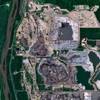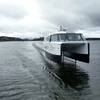In 2000, VLCCs obtained $53,000 per day, up from less than $20,000 in 1999. Old VLCCs reached $33,000 per day compared with only $11,000 in 1999. The freight market boom also had its effect on medium size crude carriers. After poor market conditions in 1999 with modern Suezmaxes obtaining $15,000 per day the average in 2000 was $40,000. Corresponding figures for modern Aframaxes were $13,000 as an average in 1999, reaching $37,000 in 2000. Peak rates in the year for both types were recorded in December at $60,000 per day.
Large clean carriers (LR2) last year obtained $32,000 per day, which is $18,000 higher than the 1999 level. Modern MR types rose from $8,000 per day to $16,000 per day in year 2000, with more than $30,000 in December.
Ship Values
Secondhand values of tankers increased in line with the freight market, but there were large variations according to type and age. Given the booming freight market in the second half of the year both resale and secondhand values for most modern tankers exceeded newbuildings prices. With net earnings of more than $1 million per month this was quite rational.
Post 1990-built crude carriers went up between 15 and 50 percent over the year. The strongest price rise was seen for Aframaxes, the weakest for VLCCs. The main explanation for these differences is the liquidity in the various segments. Another important point is that VLCC newbuilding prices for Suez- and Aframaxes were up to 17 percent. For product carriers built after mid-1980s we recorded price increases from 20 to 30 percent.
For older crude carriers values have risen by as much as between 50 and 80 percent. Older vessels will normally be subject to much larger relative price fluctuations than modern vessels, because current market conditions will be more dominating for the remaining lifetime.
Activities in the secondhand market were significantly higher in 2000 than in the year before, when transactions were at an extremely low level.
World oil production rose by more than three percent, or by 2.5 mbd. Middle East output was up as much as six to seven percent or 1.3 mbd, contributing strongly to the high growth in tanker tonnage demand.
OPEC's crude oil production surged by five percent, from 26.6 mbd in 1999 to 28 mbd in 2000. Tanker tracking data, however, suggest that seaborne liftings out of the Middle East have expanded more slowly than output. An increase in regional consumption may explain part of the gap, but certainly not all. We believe there has been substantial regional stockbuilding particularly in the second half of the year. In October/November 2000 most OPEC members were at full production capacity reaching an actual production of 29.4 mbd, compared with an estimated total capacity of 31 mbd. Only Saudi Arabia had significant spare capacity.
Seaborne Oil Trade
World seaborne trade in crude and refined products based on export figures rose by four percent. Preliminary data suggests that crude transports were up almost six percent, while transports of refined products declined by more than one percent. According to R.S. Platou estimates, there was a moderate increase in transport distances from 1999 to 2000 basically as a consequence of the strong growth in Middle East exports.
Based on tanker tracking data, Middle East exports were five percent higher in 2000 than in 1999. Crude exports increased by as much as eight percent, while exports of refined products seemed to have dropped by exports by more than 15 percent. This sharp decline is partly a result of the temporary shutdown of a large Kuwait refinery after an explosion in June, and partly a consequence of the rapid refinery expansion in Asia.
Exports from the FSU have risen sharply in 2000 due to a combination of the considerable output hike and a marginal decline in consumption. Other regions experienced only moderate changes over the previous year.
Crude imports to China doubled from 1999 to 2000 from 0.7 mbd to 1.4 mbd and accounted for more than 40 percent of the global inter-area growth in seaborne crude trade. Imports into other Asia and to the USA constituted most of the remaining growth in seaborne oil trade.
As already mentioned there must have been some other factors in addition to oil volumes and transport distances, contributing to the tanker market upswing. The most important among them is without a doubt the so-called "Erika Effect": Charterers' reduced acceptance of old tankers after the Erika accident in December 1999. According to our calculations this effect represents a three to four percent reduction in the total transport capacity of the total tanker fleet. The Erika Effect has been the strongest for Suezmaxes and Aframaxes.
In addition R.S. Platou has seen an unconventional trading pattern for tankers in 2000 that also led to reduced fleet productivity. This was mainly a consequence of low oil inventories and the persistent backwardization in the oil market. It is estimated that the "Erika Effect" combined with the unconventional trading pattern and other factors, have caused rates for crude carriers to rise by $10-20,000 per day as an average for the whole year.
The Fleet
The active tanker fleet increased by 1.6 percent from 1999 to 2000, calculated on an annual average basis. The active VLCC fleet increased by only 0.5 percent, while the rest of the tanker fleet grew 2.5 percent.
Deliveries of new tankers reached 21 million dwt in 2000, unchanged from 1999. There was a rise in removals from 13 million dwt in 1999 to 18 million dwt in 2000. Some 14 million dwt of tankers were sold for scrapping, and 25 units of these were VLCCs.
In R.S. Platou's capacity utilization rate calculations, tanker utilization rate has risen from 82 percent in the fourth quarter of 1999 to 93 percent in the fourth quarter of 2000. Utilization in 2000 was, as an annual average, close to 90 percent up from 84 percent the previous year.
According to the current order book, 15 million dwt of new tankers will be delivered in 2001. That is five million dwt less than in 1999. Scrapping of tankers is mainly determined by running and expected freight rates with age distribution as the second most important explanatory factors. The recent IMO draft to phase out old tankers will most likely be sanctioned in April 2001 leading to substantial removals from the fleet in the next five years. The first date at which old tankers will be excluded according to this new regulation, however, seems to be January 1, 2003. We expect tanker scrapping in 2001 to stay at the same level as in the second half of 2000.
Based on these assumptions the active tanker fleet will increase by 1.5 percent from 2000 to 2001 on an average basis, with higher growth for VLCCs and lower growth for medium size and small tankers.
By Erik M. Anderson, R.S. Platou Economic Research a.s., as excerpted from The Platou Report 2001.
Featured videos

Tracking Foreign Vessels Working in the U.S. Jones Act Market

Inmarsat Enhances Service to Drive Digitalization

Unlock Onboard Data Efficiencies
Subscribe for
Maritime Reporter E-News
Maritime Reporter E-News is the maritime industry's largest circulation and most authoritative ENews Service, delivered to your Email five times per week









